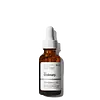What's inside
What's inside
 Key Ingredients
Key Ingredients

 Benefits
Benefits

 Concerns
Concerns

 Ingredients Side-by-side
Ingredients Side-by-side

Water
Skin ConditioningSodium Hyaluronate
HumectantCetearyl Alcohol
EmollientSqualane
EmollientCoconut Alkanes
EmollientGlycerin
HumectantPyrus Malus Fruit Extract
Skin ConditioningCoco-Caprylate/Caprate
EmollientMica
Cosmetic ColorantTitanium Dioxide
Cosmetic ColorantBakuchiol
AntimicrobialCentella Asiatica Meristem Cell Culture
AntioxidantXanthan Gum
EmulsifyingEuphrasia Officinalis Extract
AntimicrobialCetearyl Glucoside
EmulsifyingSorbitan Stearate
EmulsifyingDehydroacetic Acid
PreservativeBenzyl Alcohol
PerfumingLinoleic Acid
CleansingCetyl Hydroxyethylcellulose
Emulsion StabilisingCaffeine
Skin ConditioningTripeptide-29
Skin ConditioningPotassium Sorbate
PreservativeHydrolyzed Sodium Hyaluronate
Skin ConditioningKappaphycus Alvarezii Extract
Skin ConditioningCaesalpinia Spinosa Fruit Extract
Skin ProtectingTocopherol
AntioxidantTin Oxide
AbrasiveCaesalpinia Sappan Bark Extract
Skin ConditioningGlycyrrhiza Glabra Root Extract
BleachingHelianthus Annuus Seed Oil
EmollientArctostaphylos Uva Ursi Leaf Extract
Skin ConditioningAscorbic Acid
AntioxidantCeramide Ng
Skin ConditioningSimmondsia Chinensis Seed Oil
EmollientSalvia Officinalis Leaf Extract
CleansingArnica Montana Flower Extract
MaskingMalva Officinalis Flower Extract
Skin ConditioningCalendula Officinalis Flower Extract
MaskingChamomilla Recutita Flower Extract
MaskingWater, Sodium Hyaluronate, Cetearyl Alcohol, Squalane, Coconut Alkanes, Glycerin, Pyrus Malus Fruit Extract, Coco-Caprylate/Caprate, Mica, Titanium Dioxide, Bakuchiol, Centella Asiatica Meristem Cell Culture, Xanthan Gum, Euphrasia Officinalis Extract, Cetearyl Glucoside, Sorbitan Stearate, Dehydroacetic Acid, Benzyl Alcohol, Linoleic Acid, Cetyl Hydroxyethylcellulose, Caffeine, Tripeptide-29, Potassium Sorbate, Hydrolyzed Sodium Hyaluronate, Kappaphycus Alvarezii Extract, Caesalpinia Spinosa Fruit Extract, Tocopherol, Tin Oxide, Caesalpinia Sappan Bark Extract, Glycyrrhiza Glabra Root Extract, Helianthus Annuus Seed Oil, Arctostaphylos Uva Ursi Leaf Extract, Ascorbic Acid, Ceramide Ng, Simmondsia Chinensis Seed Oil, Salvia Officinalis Leaf Extract, Arnica Montana Flower Extract, Malva Officinalis Flower Extract, Calendula Officinalis Flower Extract, Chamomilla Recutita Flower Extract
Water
Skin ConditioningCaffeine
Skin ConditioningMaltodextrin
AbsorbentGlycerin
HumectantPropanediol
SolventEpigallocatechin Gallatyl Glucoside
AntioxidantGallyl Glucoside
AntioxidantHyaluronic Acid
HumectantOxidized Glutathione
EmollientMelanin
Skin ProtectingGlycine Soja Seed Extract
Skin ConditioningPentylene Glycol
Skin ConditioningHydroxyethylcellulose
Emulsion StabilisingPolyacrylate Crosspolymer-6
Emulsion StabilisingXanthan Gum
EmulsifyingLactic Acid
BufferingDehydroacetic Acid
PreservativeTrisodium Ethylenediamine Disuccinate
Propyl Gallate
AntioxidantDimethyl Isosorbide
SolventBenzyl Alcohol
Perfuming1,2-Hexanediol
Skin ConditioningEthylhexylglycerin
Skin ConditioningPhenoxyethanol
PreservativeCaprylyl Glycol
EmollientWater, Caffeine, Maltodextrin, Glycerin, Propanediol, Epigallocatechin Gallatyl Glucoside, Gallyl Glucoside, Hyaluronic Acid, Oxidized Glutathione, Melanin, Glycine Soja Seed Extract, Pentylene Glycol, Hydroxyethylcellulose, Polyacrylate Crosspolymer-6, Xanthan Gum, Lactic Acid, Dehydroacetic Acid, Trisodium Ethylenediamine Disuccinate, Propyl Gallate, Dimethyl Isosorbide, Benzyl Alcohol, 1,2-Hexanediol, Ethylhexylglycerin, Phenoxyethanol, Caprylyl Glycol
 Reviews
Reviews

Ingredients Explained
These ingredients are found in both products.
Ingredients higher up in an ingredient list are typically present in a larger amount.
Benzyl Alcohol is most commonly used as a preservative. It also has a subtle, sweet smell. Small amounts of Benzyl Alcohol is not irritating and safe to use in skincare products. Most Benzyl Alcohol is derived from fruits such as apricots.
Benzyl Alcohol has both antibacterial and antioxidant properties. These properties help lengthen the shelf life of products. Benzyl Alcohol is a solvent and helps dissolve other ingredients. It can also improve the texture and spreadability.
Alcohol comes in many different forms. Different types of alcohol will have different effects on skin. This ingredient is an astringent alcohol.
Using high concentrations of these alcohols are drying on the skin. They may strip away your skin's natural oils and even damage your skin barrier. Astringent alcohols may also irritate skin.
Other types of astringent alcohols include:
According to the National Rosacea Society based in the US, you should be mindful of products with these alcohols in the top half of ingredients.
Any type of sanitizing product will have high amounts of alcohol to help kill bacteria and viruses.
Learn more about Benzyl AlcoholCaffeine is most associated with coffee, tea, and cacao. In skincare, it helps with calming inflammation and is rich in antioxidants.
While caffeine is used to treat cellulite and and dark circles, further studies are needed to prove this. It has been believed to help with these skin conditions due to its ability to dilate blood vessels and increase blood flow.
Some studies are looking into caffeine's ability to protect against UV rays.
Learn more about CaffeineDehydroacetic Acid is fungicide and bactericide. It is used as a preservative in cosmetics. Preservatives help elongate the shelf life of a product.
Dehydroacetic Acid is not soluble in water.
Glycerin is already naturally found in your skin. It helps moisturize and protect your skin.
A study from 2016 found glycerin to be more effective as a humectant than AHAs and hyaluronic acid.
As a humectant, it helps the skin stay hydrated by pulling moisture to your skin. The low molecular weight of glycerin allows it to pull moisture into the deeper layers of your skin.
Hydrated skin improves your skin barrier; Your skin barrier helps protect against irritants and bacteria.
Glycerin has also been found to have antimicrobial and antiviral properties. Due to these properties, glycerin is often used in wound and burn treatments.
In cosmetics, glycerin is usually derived from plants such as soybean or palm. However, it can also be sourced from animals, such as tallow or animal fat.
This ingredient is organic, colorless, odorless, and non-toxic.
Glycerin is the name for this ingredient in American English. British English uses Glycerol/Glycerine.
Learn more about GlycerinWater. It's the most common cosmetic ingredient of all. You'll usually see it at the top of ingredient lists, meaning that it makes up the largest part of the product.
So why is it so popular? Water most often acts as a solvent - this means that it helps dissolve other ingredients into the formulation.
You'll also recognize water as that liquid we all need to stay alive. If you see this, drink a glass of water. Stay hydrated!
Learn more about WaterXanthan gum is used as a stabilizer and thickener within cosmetic products. It helps give products a sticky, thick feeling - preventing them from being too runny.
On the technical side of things, xanthan gum is a polysaccharide - a combination consisting of multiple sugar molecules bonded together.
Xanthan gum is a pretty common and great ingredient. It is a natural, non-toxic, non-irritating ingredient that is also commonly used in food products.
Learn more about Xanthan Gum